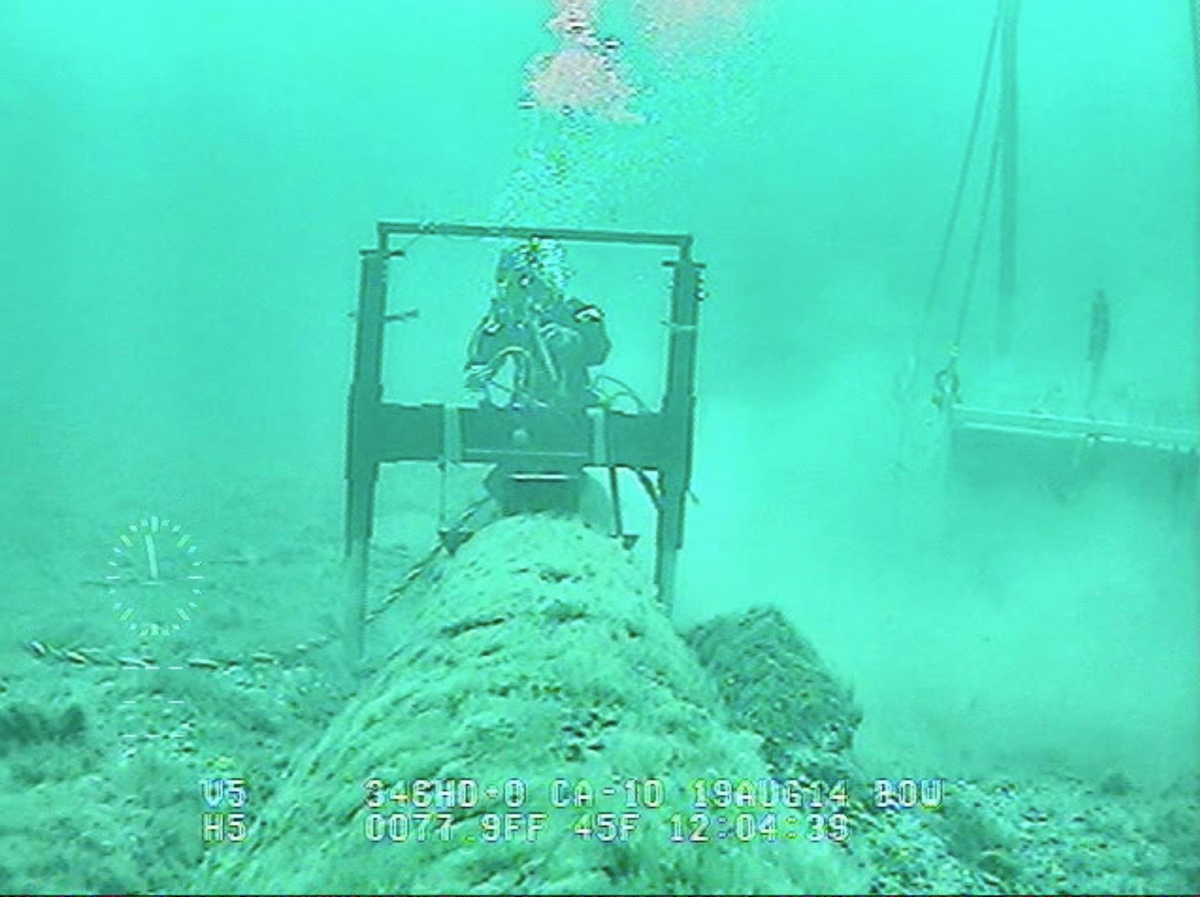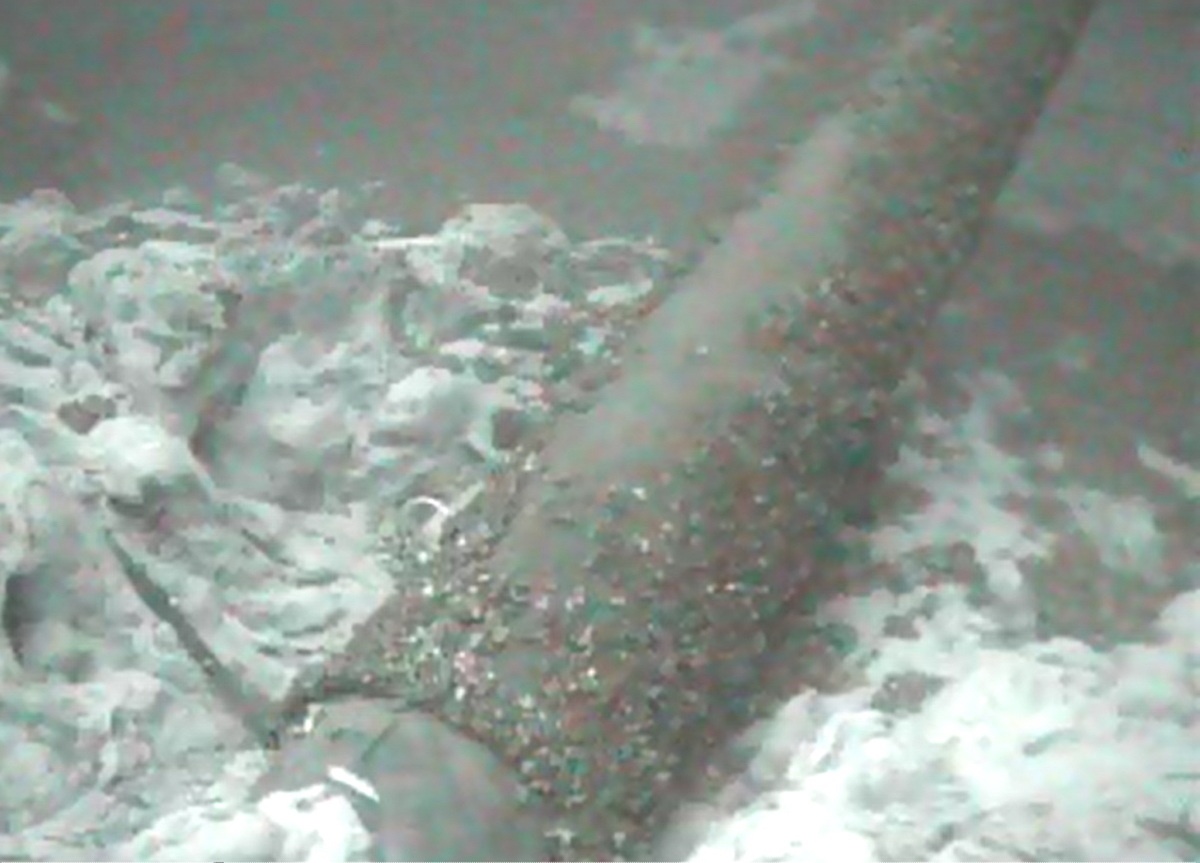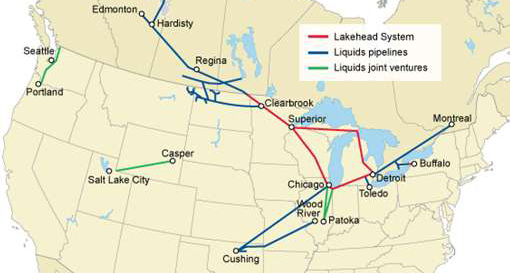Oil and water: Searching for truth on the Mackinac pipeline
In a massive drill that Canada-based Enbridge Energy insists will test the highly improbable, more than a dozen boats as well as helicopters and underwater vehicles are to converge next month on the Straits of Mackinac to gauge its potential response to a leak from its oil and natural gas pipeline.
But the exercise is not likely to quiet the debate over the 62-year-old underwater pipeline which, depending on who you ask, is either: Safe, in excellent condition and backed by reliable shutoff procedures in the remote chance of a rupture, or a Great Lakes ecological disaster waiting to happen.
The truth perhaps lies somewhere between the happy-face narrative of the oil company and the doomsday scenario of environmental groups, but gauging the precise condition of the Mackinac pipeline has proven nearly impossible. That’s because while Enbridge has stepped up inspection of its pipeline operations since a disastrous spill in the Kalamazoo River in 2010, it has refused to release the actual results of inspections, citing concerns about confidentiality while also suggesting the data is too difficult to interpret.
The company’s reluctance to disclose data has frustrated environmental groups, who contend that Enbridge’s record of past spills hardly engenders confidence, as well as government officials.
Pipeline problems
Enbridge Energy's 1900-mile U.S. pipeline system has recorded numerous spills since 1988. Some of the biggest (click each marker for details):
Last month, five years after an Enbridge pipeline rupture dumped 840,000 gallons of tar sands oil into the Kalamazoo River system near Marshall, the Michigan Petroleum Task Force called for an independent evaluation into building a pipeline that does not cross Great Lakes waters. It also demanded comprehensive, annual safety and inspection reports from Enbridge (see accompanying story) on the straits pipeline and a binding agreement from Enbridge that it will not transport tar sands crude, which can be particularly corrosive to pipelines, under the straits.
More coverage: Enbridge to Michigan: Trust us
The task force stopped short of demanding the replacement or immediate shutdown of the straits pipeline, though GOP state Attorney General Bill Schuette, who co-chairs the group, declared a pipeline like Line 5 could never be approved today, adding that its "days are numbered."
While the report was often critical of Enbridge, David Holtz, chairman of the Michigan chapter of the Sierra Club, an environmental group, called the recommendations “extremely disappointing.”
“The oil going through the pipeline should be stopped,” Holtz said. “Everything we have heard from experts suggests that it is not safe.”
Whatever the true condition of the aging pipeline, there is little dispute that a spill in the straits would be disastrous for the Great Lakes.
A 2014 University of Michigan study undertook a computer simulation into what could happen with a rupture that lasted 12 hours in the straits. It concluded that a plume of oil would not only coat the shores of Mackinac Island but spread as far west as Beaver Island in Lake Michigan, a distance of 35 miles, and as far southwest as Rogers City in Lake Huron, a distance of 50 miles.
“If you were to pick the worst possible place for an oil spill in the Great Lakes, this would be it,” said David Schwab of the U-M Water Center, which engages researchers, policymakers, and nonprofit groups to support freshwater restoration and preservation.
Nothing to worry about
The hypothetical spill is one that Enbridge said it doesn't foresee happening in the real world. The company maintains that the Straits pipeline is in “excellent condition,” safeguarded by regular inspections and backed by rigorous shutoff procedures to minimize damage from any spill.
According to a statement on an Enbridge web page: “Our Line 5 Straits of Mackinac crossing has never experienced a leak in more than 60 years of operation ‒ and we're working hard to keep it that way….”
Enbridge spokesman Jason Manshum said the firm inspects the exterior of the pipeline at least every two years, using divers and remote-controlled underwater cameras. He said Enbridge also employs standard industry inspection devices that travel through the pipe to measure and record irregularities that may indicate corrosion, cracks, dents or other defects.
“In the unlikely event of a leak, the maximum amount of time it will take to shut down the line is 10 minutes, once a leak is detected,” he said.
The company doubled the number of employees and contractors dedicated to detecting pipeline leaks, added staff to its pipeline control center and revised its shutdown procedures.
“When one or two leak triggers are identified, the controller has 10 minutes to analyze the information and conclusively rule out the possibility of a leak,” Manshum said. “If the possibility of a leak cannot be irrefutably ruled out within 10 minutes of the first leak trigger being identified, then the line is shut down, sectionalized and isolated.”
Manshum added that Enbridge has no intent to transport tar sands crude, which is generally considered more hazardous to transport than the light crude oil and liquid natural gas that now flow through Line 5.
Perhaps in a nod to mounting public pressure, company officials opened the door this week to the pipeline eventually being replaced. Speaking with reporters on Monday, Bradley Shamla, vice president for U.S. operations, said if anything “suggesting replacement" of the pipeline was needed, "we would be going down that route."
Enbridge’s record
Completed in 1953, Line 5 carries oil out of Canada 645 miles from Superior, Wis., east across the Upper Peninsula before dropping south across the Straits of Mackinac at depths of up to 270 feet just west of the Mackinac Bridge. A 30-inch pipe nearly all its length, it splits into two 20-inch sections a thousand feet apart at the straits.
With a .8-inch exterior wall thickness, encrusted in places with zebra mussel and seaweed, the twin pipelines transport some 23 million gallons of oil and liquid gas a day through the 4.6-mile crossing. The pipeline then heads southeast through the Lower Peninsula before crossing the St. Clair River into Sarnia, Ontario.
Beth Wallace, a consultant to the Ann Arbor-based Great Lakes Regional Center of the National Wildlife Federation, said Enbridge’s track record for transparency and pipeline safety does not inspire confidence.
She noted that the state task force concluded that Enbridge has not fully shared its inspection and safety information on the Straits pipeline, failed to maintain underwater structural supports as the state required of it back in 1953, and failed to acknowledge the potential threat posed by zebra and quagga mussels, which secrete an acid that can be corrosive to steel.
“They say to trust us, that it's safe,” Wallace said, “but their actions don't live up to their words.”
Independent experts say Enbridge has contributed to public skepticism by releasing only summaries of its pipeline inspections, not the raw data.
“From what I’ve seen they’ve run the right tools, but I can’t tell you what the results are because I haven’t seen them," Richard Kuprewicz, a pipeline safety expert, told Michigan Radio, echoing the frustrations of the state task force report.
Adding to doubts, in 2013, a NWF-backed diving expedition to inspect the Straits pipeline found that some support structures had fallen away and that the pipeline in places was covered in debris and mussels. In 2014, Enbridge agreed to add additional support structures so they would be no more than 75 feet apart, as specified by the easement the state granted to Enbridge.
Wallace also is co-author of a 2012 NWF report that charted a series of Enbridge leaks, in addition to the infamous Marshall spill, that date back to 1988. They include incidents throughout its Lakehead pipeline network, 1,900 miles of U.S. pipeline that includes Line 5:
- 1988: A corroded section of pipeline in Macomb County ruptured, dumping 320,000 gallons of crude oil into the Clinton River. Pipeline workers used propane torches to burn oil off the river surface and its banks.
- 1991: Northwest of Duluth, Minn., a rupture spilled 1.7 million gallons of oil. According to state records some 4 million gallons of oil had by then spilled from the pipeline in 16 incidents, including the 1991 rupture, since the early 1970s.
- 1999: Near the Upper Peninsula town of Crystal Falls, a natural gas and oil pipeline failed, spilling 226,000 gallons of oil and natural gas into a marsh. According to the NWF report on Enbridge, Enbridge officials ignited the natural gas vapor cloud to keep it from spreading, touching off a fire that burned eight acres. Investigators say the pipe failed because it rested on a rock formation, weakening it over time.
- 2002: A 34-inch pipeline ruptured northwest of Duluth, Minn., dumping 250,000 gallons of oil into a bog. With much of the oil pooled on the ground, officials ignited it, sending up a mile-high smoke plume.
- 2007: Work crews preparing to extend a new pipeline struck an existing pipeline in northwest Wisconsin, spilling what is later determined to be more than 200,000 gallons of oil. State officials find evidence some of the oil contaminated the local water table.
Overall, according to the NWF report, Enbridge pipelines in Canada and the United States had more than 800 leaks between 1999 and 2010. Manshum, the Enbridge spokesman, paints a more benign portrait, saying Enbridge had 559 reportable releases in its facilities in the United States and Canada and 107 outside its facilities. He said “most” releases were less than a barrel in volume and readily contained.
Enbridge’s safety record, he said, is above the industry average.
Memories fresh from Marshall
Residents of Marshall, east of Battle Creek, have vivid memories of what happened the evening of July 25, 2010, and in the days afterward.
Just before 6 p.m., an alarm went off at the Enbridge pipeline control center in Edmonton, Alberta, signaling a drop in pressure at the Marshall pump station. About three hours later, Calhoun County dispatchers began receiving calls from residents reporting the odor of natural gas. Firefighters dispatched to the scene could not locate the source.
It was not until after 11 a.m. the following morning – 17 hours after the initial alarm – that Enbridge shut off the leaking pipeline after being alerted by a Consumers Energy employee on the scene. By then, it had spilled more than 800,000 gallons of tar sands crude into Talmadge Creek, which empties into the Kalamazoo River. Oil was subsequently detected along a 38-mile stretch of the river.
Enbridge estimates its cleanup costs at $1.2 billion, including a $75 million settlement with the state for wetland and stream restoration and other improvements. It still faces a likely fine from the U.S. Environmental Protection Agency.
“They say to trust us, that it’s safe. But their actions don’t live up to their words.” – Beth Wallace, NWF consultant
A 2012 report by the National Transportation Safety Board concluded that Enbridge knew five years before the Marshall rupture that there were cracks in the section of pipeline that failed. It also faulted Enbridge pipeline control officials for failing to responding to numerous alarms, noting they mistakenly “interpreted them as indications of an incompletely filled pipeline” and continued pumping oil through the line.
In testimony about the spill, NTSB Chairwoman Deborah Hersman said: “Learning about Enbridge’s poor handling of the rupture, you can’t help but think of the Keystone Kops.”
Ten days before the Marshall spill, Richard Adams, vice president of U.S. operations for liquid pipelines, testified before a Congressional subcommittee about Enbridge's capacity to handle a leak.
“Our response time from our control center can be almost instantaneous…,” he said.
Environmentalists press cause
On Aug. 5, a dozen Michigan environmental and citizen groups sent a letter to Schuette, Gov. Rick Snyder and the directors of the DEQ and Department of Natural Resources demanding immediate action to shut down the straits pipeline.
“Anything less puts the Great Lakes at an unacceptable risk...” it stated.
Asked to comment, Snyder spokesman Dave Murray said the governor expected “to address recommendations included in the (task force) report quickly.” He did not say whether Snyder would press for a shutdown.
Andrea Bitely, spokesperson for Schuette, said “the reason we aren’t calling for an immediate shutdown is because we have to find an alternate path for that oil, which provides oil and natural gas to people throughout our region, and an immediate shutdown could cause that oil to be transported via freighter on our lakes, something that doesn’t appeal to most folks, either.”
Enbridge spokesman Manshum said the firm learned from the 2010 Marshall spill, calling it “one of the bleakest and most humbling chapters in our company’s 65-year history.”
As a result, Manshum said, it has taken measures to ensure an accident like that will not happen again.
But Enbridge’s claims have not softened the worries of Holtz of the Sierra Club.
Even if Enbridge succeeds in shutting down a leak in just 10 minutes, he said, that could still leave the Straits with a spill of some 320,000 gallons.
“That’s not reassuring,” Holtz said. “The only way to protect the Great Lakes from a catastrophic spill is to shut off the oil going through the straits.”
See what new members are saying about why they donated to Bridge Michigan:
- “In order for this information to be accurate and unbiased it must be underwritten by its readers, not by special interests.” - Larry S.
- “Not many other media sources report on the topics Bridge does.” - Susan B.
- “Your journalism is outstanding and rare these days.” - Mark S.
If you want to ensure the future of nonpartisan, nonprofit Michigan journalism, please become a member today. You, too, will be asked why you donated and maybe we'll feature your quote next time!


 A diver for Enbridge Energy inspects the Straits of Mackinac pipeline. (Photo courtesy Enbridge Energy)
A diver for Enbridge Energy inspects the Straits of Mackinac pipeline. (Photo courtesy Enbridge Energy) A 2013 diving expedition funded by the National Wildlife Federation found the straits pipeline encrusted with zebra mussels. (Photo courtesy National Wildlife Federation)
A 2013 diving expedition funded by the National Wildlife Federation found the straits pipeline encrusted with zebra mussels. (Photo courtesy National Wildlife Federation) Enbridge Energy pumps about 1.4 million barrels of oil and liquid natural gas through 3,000 miles of pipeline in the United States and Canada. (Click to enlarge.)
Enbridge Energy pumps about 1.4 million barrels of oil and liquid natural gas through 3,000 miles of pipeline in the United States and Canada. (Click to enlarge.)